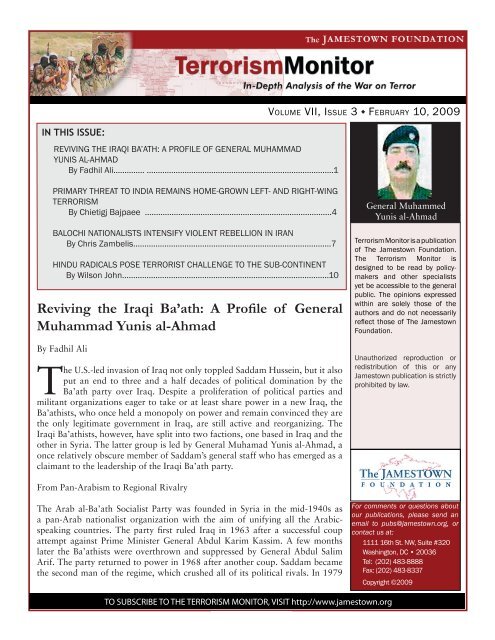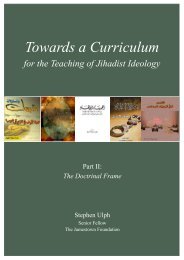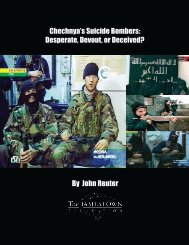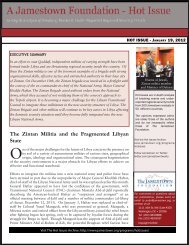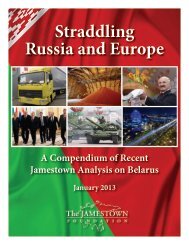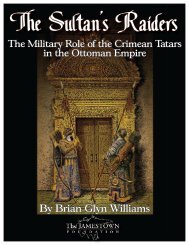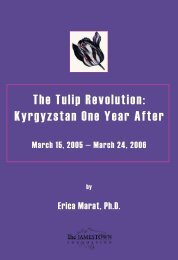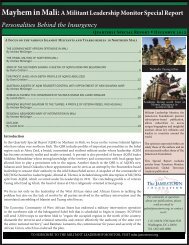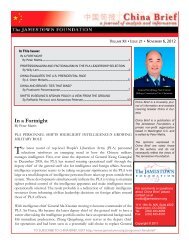Reviving the Iraqi Ba'ath: A Profile of General Muhammad Yunis al ...
Reviving the Iraqi Ba'ath: A Profile of General Muhammad Yunis al ...
Reviving the Iraqi Ba'ath: A Profile of General Muhammad Yunis al ...
You also want an ePaper? Increase the reach of your titles
YUMPU automatically turns print PDFs into web optimized ePapers that Google loves.
IN THIS ISSUE:<br />
<strong>Reviving</strong> <strong>the</strong> iRaqi Ba’ath: a PR<strong>of</strong>ile <strong>of</strong> geneR<strong>al</strong> MuhaMMad<br />
<strong>Yunis</strong> <strong>al</strong>-ahMad<br />
By fadhil <strong>al</strong>i.............. ....................................................................................1<br />
PRiMaRY thReat to india ReMains hoMe-gRown left- and Right-wing<br />
teRRoRisM<br />
By Chietigj Bajpaee ....................................................................................4<br />
B<strong>al</strong>oChi nation<strong>al</strong>ists intensifY violent ReBellion in iRan<br />
By Chris Zambelis.........................................................................................7<br />
hindu RadiC<strong>al</strong>s Pose teRRoRist Ch<strong>al</strong>lenge to <strong>the</strong> suB-Continent<br />
By wilson John.............................................................................................10<br />
<strong>Reviving</strong> <strong>the</strong> <strong>Iraqi</strong> Ba’ath: A <strong>Pr<strong>of</strong>ile</strong> <strong>of</strong> <strong>Gener<strong>al</strong></strong><br />
<strong>Muhammad</strong> <strong>Yunis</strong> <strong>al</strong>-Ahmad<br />
By Fadhil Ali<br />
The U.S.-led invasion <strong>of</strong> Iraq not only toppled Saddam Hussein, but it <strong>al</strong>so<br />
put an end to three and a h<strong>al</strong>f decades <strong>of</strong> politic<strong>al</strong> domination by <strong>the</strong><br />
Ba’ath party over Iraq. Despite a proliferation <strong>of</strong> politic<strong>al</strong> parties and<br />
militant organizations eager to take or at least share power in a new Iraq, <strong>the</strong><br />
Ba’athists, who once held a monopoly on power and remain convinced <strong>the</strong>y are<br />
<strong>the</strong> only legitimate government in Iraq, are still active and reorganizing. The<br />
<strong>Iraqi</strong> Ba’athists, however, have split into two factions, one based in Iraq and <strong>the</strong><br />
o<strong>the</strong>r in Syria. The latter group is led by <strong>Gener<strong>al</strong></strong> Muhamad <strong>Yunis</strong> <strong>al</strong>-Ahmad, a<br />
once relatively obscure member <strong>of</strong> Saddam’s gener<strong>al</strong> staff who has emerged as a<br />
claimant to <strong>the</strong> leadership <strong>of</strong> <strong>the</strong> <strong>Iraqi</strong> Ba’ath party.<br />
From Pan-Arabism to Region<strong>al</strong> Riv<strong>al</strong>ry<br />
The Arab <strong>al</strong>-Ba’ath Soci<strong>al</strong>ist Party was founded in Syria in <strong>the</strong> mid-1940s as<br />
a pan-Arab nation<strong>al</strong>ist organization with <strong>the</strong> aim <strong>of</strong> unifying <strong>al</strong>l <strong>the</strong> Arabicspeaking<br />
countries. The party first ruled Iraq in 1963 after a successful coup<br />
attempt against Prime Minister <strong>Gener<strong>al</strong></strong> Abdul Karim Kassim. A few months<br />
later <strong>the</strong> Ba’athists were overthrown and suppressed by <strong>Gener<strong>al</strong></strong> Abdul S<strong>al</strong>im<br />
Arif. The party returned to power in 1968 after ano<strong>the</strong>r coup. Saddam became<br />
<strong>the</strong> second man <strong>of</strong> <strong>the</strong> regime, which crushed <strong>al</strong>l <strong>of</strong> its politic<strong>al</strong> riv<strong>al</strong>s. In 1979<br />
Volume VII, Issue 3 u February 10, 2009<br />
TO SUBSCRIBE TO THE TERRORISM MONITOR, VISIT http://www.jamestown.org<br />
<strong>Gener<strong>al</strong></strong> Muhammed<br />
<strong>Yunis</strong> <strong>al</strong>-Ahmad<br />
terrorism Monitor is a publication<br />
<strong>of</strong> <strong>the</strong> Jamestown foundation.<br />
<strong>the</strong> terrorism Monitor is<br />
designed to be read by policymakers<br />
and o<strong>the</strong>r speci<strong>al</strong>ists<br />
yet be accessible to <strong>the</strong> gener<strong>al</strong><br />
public. <strong>the</strong> opinions expressed<br />
within are solely those <strong>of</strong> <strong>the</strong><br />
authors and do not necessarily<br />
reflect those <strong>of</strong> The Jamestown<br />
foundation.<br />
unauthorized reproduction or<br />
redistribution <strong>of</strong> this or any<br />
Jamestown publication is strictly<br />
prohibited by law.<br />
For comments or questions about<br />
our publications, please send an<br />
email to pubs@jamestown.org, or<br />
contact us at:<br />
1111 16th st. nw, suite #320<br />
Washington, DC • 20036<br />
tel: (202) 483-8888<br />
fax: (202) 483-8337<br />
Copyright ©2009
terrorismMonitor volume vii u issue 3 u february 10, 2009<br />
Saddam became president until <strong>the</strong> 2003 U.S. invasion<br />
ended <strong>the</strong> second Ba’athist reign in Iraq. Although<br />
Saddam was not popular in Iraq, hundred <strong>of</strong> thousands<br />
<strong>of</strong> <strong>Iraqi</strong>s were members <strong>of</strong> his party. Many were sincere<br />
party members, but o<strong>the</strong>rs had to join <strong>the</strong> organization to<br />
pursue <strong>the</strong>ir education or keep <strong>the</strong>ir jobs as government<br />
employees.<br />
Since <strong>the</strong> late 1960s, Iraq and Syria were ruled by two<br />
riv<strong>al</strong> wings <strong>of</strong> <strong>al</strong>-Ba’ath. The person<strong>al</strong> and politic<strong>al</strong><br />
animosity between Syria’s President Hafiz <strong>al</strong>-Assad and<br />
President Saddam Hussein dominated region<strong>al</strong> politics<br />
for decades. The pan-Arab party command was split in<br />
two, with Ba’athists around <strong>the</strong> Arab world having to<br />
choose between <strong>the</strong> <strong>Iraqi</strong> or Syrian faction. The Syrians<br />
were unable to welcome <strong>the</strong> f<strong>al</strong>l <strong>of</strong> Saddam as it put<br />
<strong>the</strong>m under direct American pressure. As a result, Syria<br />
became a gateway for foreign fighters on <strong>the</strong>ir way to<br />
Iraq.<br />
Al-Baath was outlawed after <strong>the</strong> war. The members<br />
<strong>of</strong> <strong>the</strong> top four levels <strong>of</strong> <strong>the</strong> party were excluded from<br />
public life by order <strong>of</strong> U.S. Ambassador Paul Bremer, <strong>the</strong><br />
administrator <strong>of</strong> <strong>the</strong> Co<strong>al</strong>ition Provision<strong>al</strong> Authority.<br />
Saddam and most <strong>of</strong> <strong>the</strong> leading figures <strong>of</strong> his regime<br />
were captured one by one. Some Ba’athists, however,<br />
did not accept <strong>the</strong> defeat easily and formed underground<br />
organizations. One <strong>of</strong> those is led by Syrian-based<br />
<strong>Gener<strong>al</strong></strong> <strong>Muhammad</strong> <strong>Yunis</strong> <strong>al</strong>-Ahmad, a senior member<br />
<strong>of</strong> <strong>al</strong>-Ba’ath under Saddam.<br />
<strong>Reviving</strong> <strong>the</strong> Party in Syria<br />
<strong>Gener<strong>al</strong></strong> <strong>al</strong>-Ahmad’s highest post under Saddam was his<br />
membership in <strong>the</strong> supreme command <strong>of</strong> <strong>al</strong>-Baath party.<br />
The gener<strong>al</strong> seems to have an ide<strong>al</strong> resume for someone<br />
who would want to build a Ba’athist paramilitary<br />
organization, having worked in <strong>the</strong> so-c<strong>al</strong>led Politic<strong>al</strong><br />
Guidance Directorate <strong>of</strong> <strong>the</strong> former Iraq Army. That<br />
department was in charge <strong>of</strong> ensuring <strong>the</strong> complete<br />
control <strong>of</strong> <strong>al</strong>-Ba’ath over <strong>the</strong> <strong>Iraqi</strong> armed forces through<br />
a network <strong>of</strong> loy<strong>al</strong> <strong>of</strong>ficers in every unit. After that,<br />
<strong>Gener<strong>al</strong></strong> <strong>al</strong>-Ahmad occupied a senior post in <strong>the</strong> military<br />
bureau <strong>of</strong> <strong>the</strong> party. 1<br />
1 Information on <strong>al</strong>-Ahmad from an interview with<br />
<strong>Gener<strong>al</strong></strong> Wafiq <strong>al</strong>-Samarai, head <strong>of</strong> <strong>Iraqi</strong> military intelligence<br />
in early 1990s. <strong>Gener<strong>al</strong></strong> <strong>al</strong>-Samarai fled <strong>the</strong> country<br />
and joined <strong>the</strong> opposition, eventu<strong>al</strong>ly becoming <strong>the</strong><br />
top military advisor to current <strong>Iraqi</strong> president J<strong>al</strong><strong>al</strong> <strong>al</strong>-<br />
T<strong>al</strong>ibani. Al-Samarai points out that <strong>the</strong> main area <strong>of</strong> <strong>al</strong>-<br />
Ahmad’s activities is in and around <strong>the</strong> nor<strong>the</strong>rn city <strong>of</strong><br />
Mosul, with a presence in <strong>al</strong>-Anbar, Kirkuk, and Diy<strong>al</strong>a.<br />
2<br />
Al-Ahmad was not one <strong>of</strong> <strong>the</strong> 55 most-wanted <strong>Iraqi</strong><br />
<strong>of</strong>fici<strong>al</strong>s depicted in <strong>the</strong> famous set <strong>of</strong> playing cards<br />
distributed by <strong>the</strong> U.S. Army during <strong>the</strong> invasion. A few<br />
months later <strong>the</strong> Co<strong>al</strong>ition acknowledged <strong>the</strong>ir oversight<br />
by issuing a million dollar reward for information<br />
leading to his arrest (Middle East Online, February 18,<br />
2004).<br />
<strong>Gener<strong>al</strong></strong> <strong>al</strong>-Ahmad was mentioned when Moyayad<br />
Yaseen Ahmad, <strong>the</strong> leader <strong>of</strong> <strong>the</strong> Jaysh <strong>Muhammad</strong> (The<br />
Army <strong>of</strong> [<strong>the</strong> Prophet] <strong>Muhammad</strong>) insurgent group, was<br />
arrested. The government said <strong>the</strong> captured insurgent<br />
had visited Syria, where he met with <strong>Gener<strong>al</strong></strong> <strong>al</strong>-Ahmad<br />
to coordinate joint efforts in <strong>the</strong> insurgency (<strong>al</strong>-Sharq <strong>al</strong>-<br />
Awsat, November 17, 2004). On December 6, 2004 <strong>the</strong><br />
<strong>Iraqi</strong> government-owned <strong>al</strong>-Sabah newspaper reported:<br />
A group <strong>of</strong> fugitive members <strong>of</strong> <strong>al</strong>-Ba’ath held a<br />
conference in <strong>the</strong> Syrian city <strong>of</strong> <strong>al</strong>-Hasaka lately.<br />
They elected <strong>the</strong> (crimin<strong>al</strong>) <strong>Muhammad</strong> <strong>Yunis</strong> <strong>al</strong>-<br />
Ahmad as secretary-gener<strong>al</strong> <strong>of</strong> <strong>the</strong> party in Iraq.<br />
The attendees <strong>of</strong>fered to stop <strong>the</strong> insurgency in<br />
six hours if <strong>the</strong> <strong>Iraqi</strong> government <strong>al</strong>lowed <strong>the</strong>m<br />
to participate in <strong>the</strong> politic<strong>al</strong> process. It was not<br />
clear how serious <strong>the</strong> <strong>of</strong>fer was. But <strong>the</strong> <strong>Iraqi</strong><br />
government continues its effort to capture <strong>al</strong>-<br />
Ahmad, labeling him as a terrorist who leads and<br />
funds insurgent groups.<br />
Al-Ba’ath after Saddam<br />
Saddam Hussein was <strong>the</strong> secretary-gener<strong>al</strong> <strong>of</strong> <strong>the</strong> Arab<br />
Ba’ath soci<strong>al</strong>ist party since 1979. Even after his capture<br />
in 2003 he was still recognized by <strong>the</strong> <strong>Iraqi</strong> Ba’athists<br />
as <strong>the</strong> supreme leader. Following Saddam’s execution<br />
in December 30, 2006, <strong>Gener<strong>al</strong></strong> <strong>al</strong>-Ahmad made his<br />
most serious attempt to succeed <strong>the</strong> late party leader<br />
by c<strong>al</strong>ling for a gener<strong>al</strong> conference <strong>of</strong> <strong>the</strong> party in Syria<br />
to elect a new leadership. The move was condemned by<br />
<strong>the</strong> followers <strong>of</strong> former vice-president Izzat Ibrahim <strong>al</strong>-<br />
Douri, who had <strong>al</strong>ready claimed Saddam’s succession.<br />
Unlike <strong>the</strong> conference <strong>of</strong> 2004, this meeting ignited<br />
a huge controversy among <strong>the</strong> Ba’athists. Al-Douri<br />
criticized Syria for supporting an American conspiracy<br />
against <strong>the</strong> <strong>Iraqi</strong> Ba’ath, though shortly afterwards his<br />
spokesman played down those remarks (<strong>al</strong>-Arabiya,<br />
January 22, 2007).<br />
The conference was held without any direct media<br />
coverage; no pictures were available from <strong>the</strong> event.<br />
<strong>Gener<strong>al</strong></strong> <strong>al</strong>-Ahmad ordered <strong>the</strong> expulsion <strong>of</strong> <strong>al</strong>-Douri<br />
from <strong>the</strong> party, but <strong>al</strong>-Douri had <strong>al</strong>ready ordered
terrorismMonitor volume vii u issue 3 u february 10, 2009<br />
<strong>the</strong> dismiss<strong>al</strong> <strong>of</strong> <strong>al</strong>-Ahmad and 150 o<strong>the</strong>r members.<br />
The <strong>Iraqi</strong> Ba’ath party has since split into riv<strong>al</strong> wings<br />
(Alm<strong>al</strong>afpress.net, April 25, 2007).<br />
Although <strong>the</strong> supporters <strong>of</strong> <strong>al</strong>-Douri accused <strong>al</strong>-Ahmad’s<br />
group <strong>of</strong> being keen to contact <strong>the</strong> <strong>Iraqi</strong> government,<br />
this has not yet been proved. Former <strong>Iraqi</strong> presidenti<strong>al</strong><br />
advisor <strong>Gener<strong>al</strong></strong> Wafiq <strong>al</strong>-Samarai was reported to have<br />
met with <strong>al</strong>-Ahmad’s aides in Jordan in 2007 (<strong>al</strong>nazaha.<br />
org, April 28, 2007), but denied ever meeting with<br />
any <strong>of</strong> <strong>al</strong>-Ahmad’s representatives in an interview with<br />
Jamestown. Al-Samarai said that he believed <strong>al</strong>-Ahmad’s<br />
organization would remain a secret armed group and its<br />
leading figures would stay in Syria.<br />
Al-Ahmad’s Role in <strong>the</strong> Insurgency<br />
In two TV interviews in 2007, <strong>Gener<strong>al</strong></strong> Gazwan <strong>al</strong>-<br />
Kubaisi, <strong>the</strong> second man in <strong>al</strong>-Ahmad’s group, portrayed<br />
<strong>the</strong> strategy <strong>of</strong> his party in <strong>the</strong> insurgency:<br />
We asked our supporters in Iraq to join o<strong>the</strong>r<br />
groups as our abilities are still weak… We do not<br />
care who is leading <strong>the</strong> insurgency, whe<strong>the</strong>r <strong>the</strong><br />
Islamists or <strong>the</strong> Ba’athists, [so long as] <strong>the</strong> Islamist<br />
armed groups are filled with Ba’athists... We are<br />
open to cooperation with any armed group that<br />
targets <strong>the</strong> occupier enemy [<strong>the</strong> Co<strong>al</strong>ition forces]<br />
and <strong>the</strong> collaborating government but not <strong>the</strong><br />
<strong>Iraqi</strong> people.<br />
Al-Kubaisi <strong>al</strong>so c<strong>al</strong>led for <strong>the</strong> Americans to withdraw<br />
<strong>the</strong>ir troops from Iraq and claimed his party could help<br />
in securing such a withdraw<strong>al</strong>:<br />
They should leave and not stay for years - we<br />
could help <strong>the</strong>m to withdraw without losing face.<br />
Our conditions are: They should release <strong>al</strong>l <strong>the</strong><br />
<strong>Iraqi</strong> prisoners from <strong>the</strong>ir jails and from [those<br />
<strong>of</strong>] <strong>the</strong> collaborating government. They have to<br />
hand over <strong>the</strong> collaborating government to be<br />
tried by <strong>Iraqi</strong>s. They must rebuild everything that<br />
was damaged in Iraq. They must apologize to <strong>the</strong><br />
<strong>Iraqi</strong> people, to <strong>the</strong> Arab nation, to <strong>al</strong>l Muslims<br />
and to humanity for <strong>the</strong> crime <strong>of</strong> letting Safavids<br />
execute Saddam Hussein (<strong>al</strong>-Arabiya, August 29,<br />
2007; Al-Baghdadiyah TV [Cairo], December 9,<br />
2007). 2<br />
2 “Safavids” refers to <strong>the</strong> Safavid Dynasty that ruled<br />
Iran and large areas in west Asia in <strong>the</strong> 16th and 17th centuries.<br />
The <strong>Iraqi</strong> Ba’athists use <strong>the</strong> term to refer to <strong>the</strong> Iranians<br />
and <strong>the</strong>ir <strong>al</strong>lies in <strong>the</strong> <strong>Iraqi</strong> Shiite parties. As secu-<br />
3<br />
In addition to <strong>Gener<strong>al</strong></strong> <strong>al</strong>-Ahmad and <strong>Gener<strong>al</strong></strong> <strong>al</strong>-<br />
Kubaisi, <strong>the</strong> Syrian-based Ba’ath faction is believed to<br />
include most <strong>of</strong> <strong>the</strong> remaining leading figures <strong>of</strong> <strong>the</strong><br />
party, including Mezher Motni Awad, To’ma Di’aiyef<br />
Getan, Jabbar Haddoosh, Sajer Zubair, and Nihad <strong>al</strong>-<br />
Dulaimi.<br />
Aside from <strong>the</strong> military representation in <strong>al</strong>-Ahmad’s<br />
group, <strong>the</strong> organization is <strong>al</strong>so believed to have made<br />
some inroads among <strong>the</strong> majority Shi’a. Although <strong>al</strong>-<br />
Ahmad and his senior aides are Sunnis, his organization<br />
has many Shiites in <strong>the</strong> middle level. Al-Douri has held<br />
to conservative Islamic policies based on his Sunni<br />
faith. Al-Ahmad, however, took <strong>the</strong> opportunity <strong>of</strong><br />
returning to <strong>the</strong> party’s origin<strong>al</strong> pan-Arab nation<strong>al</strong>ist<br />
secular ideology. This has proved attractive to some<br />
former Ba’athist Shiites from sou<strong>the</strong>rn Iraq, especi<strong>al</strong>ly<br />
those who have not been integrated into post-war Iraq<br />
as a result <strong>of</strong> <strong>the</strong>ir party membership (Alm<strong>al</strong>afpress.net,<br />
April 25, 2007; see <strong>al</strong>so Terrorism Focus, January 21).<br />
Still, <strong>al</strong>-Ahmad seems to have failed to overthrow <strong>al</strong>-<br />
Douri. Al-Douri’s followers are more active on <strong>the</strong><br />
internet and most <strong>of</strong> <strong>the</strong> pro-Ba’athist websites recognize<br />
<strong>al</strong>-Douri as <strong>the</strong> head <strong>of</strong> <strong>the</strong> party. Al-Ahmad does not<br />
even have exclusive support from <strong>the</strong> Syrian government<br />
and his group is susceptible to Syrian interference in <strong>Iraqi</strong><br />
Ba’athist affairs. Also, Syrian support is not necessarily<br />
an advantage for <strong>the</strong> <strong>Iraqi</strong> Ba’thists. In addition to <strong>the</strong><br />
historic<strong>al</strong> animosity between <strong>the</strong> Ba’ath membership in<br />
<strong>the</strong> two countries, <strong>the</strong> <strong>Iraqi</strong>s could not ignore that Syria<br />
is <strong>the</strong> main <strong>al</strong>ly <strong>of</strong> <strong>the</strong>ir riv<strong>al</strong>, Iran.<br />
Conclusion<br />
Despite <strong>the</strong>ir differences, both factions <strong>of</strong> <strong>the</strong> Ba’ath<br />
party have <strong>the</strong> same ideology and go<strong>al</strong>s. Al-Ahmad<br />
will have to work hard to gain <strong>the</strong> support <strong>of</strong> what is<br />
left <strong>of</strong> <strong>the</strong> Ba’athist base. The image <strong>of</strong> being under <strong>the</strong><br />
influence <strong>of</strong> <strong>the</strong> Syrian government will not help him<br />
in this context. Al-Ahmad probably will focus on <strong>the</strong><br />
military side where his experience and contacts lay.<br />
The strategy used against <strong>al</strong>-Qaeda in Iraq will not<br />
automatic<strong>al</strong>ly work against <strong>al</strong>-Ba’ath. Iraq and Syria<br />
have recently ended a 24-year break in diplomatic<br />
relations, which should encourage <strong>the</strong> two countries to<br />
raise <strong>the</strong> level <strong>of</strong> security coordination between <strong>the</strong>m.<br />
This will deny <strong>Gener<strong>al</strong></strong> <strong>al</strong>-Ahmad and his group <strong>the</strong><br />
larists, <strong>the</strong> Ba’athists do not deny Shiite Islam, but by<br />
using <strong>the</strong> term Safavid <strong>the</strong>y show <strong>the</strong>ir disrespect for <strong>the</strong><br />
Iranian interpretation <strong>of</strong> Shiite Islam. The Ba’athists believe<br />
that <strong>the</strong> origin <strong>of</strong> Shiite Islam is Arab, not Persian.
terrorismMonitor volume vii u issue 3 u february 10, 2009<br />
safe haven <strong>the</strong>y have been enjoying for years. The <strong>Iraqi</strong><br />
government efforts to integrate more former <strong>al</strong>-Ba’ath<br />
loy<strong>al</strong>ists will make it harder for <strong>al</strong>-Ahmad or any o<strong>the</strong>r<br />
Ba’athists to re-structure an influenti<strong>al</strong> organization by<br />
recruiting segregated former comrades.<br />
Fadhil Ali is a freelance journ<strong>al</strong>ist based in Iraq who<br />
speci<strong>al</strong>izes in <strong>Iraqi</strong> insurgent groups.<br />
Primary Threat to India Remains<br />
Home-Grown Left- and Right-<br />
Wing Terrorism<br />
By Chietigj Bajpaee<br />
While <strong>the</strong> fedayeen-style terrorist attacks in<br />
Mumbai in November 2008 drew attention to<br />
<strong>the</strong> recurring role <strong>of</strong> Pakistan-based militant<br />
groups in fuelling instability in India, home-grown<br />
left- and right-wing extremists continue to present<br />
a growing and potenti<strong>al</strong>ly more significant threat to<br />
India’s security. In <strong>the</strong> case <strong>of</strong> left-wing terrorism, <strong>the</strong><br />
Nax<strong>al</strong>ite (communist) insurgency represents a longstanding,<br />
well-entrenched, and widespread threat to<br />
India’s security and governance structures. 1 Meanwhile,<br />
right-wing terrorism, represented in a string <strong>of</strong> attacks<br />
attributed to home-grown Islamic and Hindu extremist<br />
groups, <strong>al</strong>though in its infancy, presents a new and<br />
unfamiliar threat that has caught India’s security<br />
establishment unprepared. The Mumbai terrorist attacks<br />
have revived <strong>the</strong> debate on upgrading India’s antiterrorism<br />
infrastructure. Whe<strong>the</strong>r <strong>the</strong>se initiatives lead<br />
to a substantive improvement in <strong>the</strong> country’s security<br />
environment or are mere token gestures to appease <strong>the</strong><br />
electorate ahead <strong>of</strong> <strong>the</strong> country’s parliamentary elections<br />
by May 2009 remains to be seen.<br />
A Growing Red Corridor<br />
Despite <strong>the</strong> world’s focus on <strong>the</strong> disputed territory <strong>of</strong><br />
Kashmir as <strong>the</strong> foc<strong>al</strong> point <strong>of</strong> a two-decade insurgency<br />
and potenti<strong>al</strong> nuclear stand-<strong>of</strong>f between India and<br />
Pakistan, Indian Prime Minister Manmohan Singh has<br />
described <strong>the</strong> four-decade Nax<strong>al</strong>ite insurgency as <strong>the</strong><br />
greatest threat to India’s intern<strong>al</strong> security (The Hindu,<br />
1 The term Nax<strong>al</strong>ite comes from <strong>the</strong> West Beng<strong>al</strong>i village<br />
<strong>of</strong> Nax<strong>al</strong>bari, where a 1967 uprising was led by a faction<br />
<strong>of</strong> <strong>the</strong> Communist Party <strong>of</strong> India (Marxist) (CPI-M).<br />
It is applied today to a variety <strong>of</strong> left-wing militant groups.<br />
4<br />
March 6, 2007). Since <strong>the</strong> merger <strong>of</strong> <strong>the</strong> People’s War<br />
Group (PWG) and <strong>the</strong> Maoist Communist Center<br />
(MCC) into <strong>the</strong> Communist Party <strong>of</strong> India (Maoist) in<br />
September 2004, <strong>the</strong> Nax<strong>al</strong>ite insurgency has grown to<br />
now affect some 170 districts across 13 states in centr<strong>al</strong><br />
and eastern India (Business Standard [India], June 30<br />
2007). The insurgency, which emerged in <strong>the</strong> town <strong>of</strong><br />
Nax<strong>al</strong>buri in West Beng<strong>al</strong> in 1967, claimed more than<br />
800 lives in over 1,500 incidents in 2007 according<br />
to India’s Home Affairs Ministry, with <strong>the</strong> greatest<br />
concentration <strong>of</strong> attacks in <strong>the</strong> states <strong>of</strong> Chhattisgarh,<br />
Jharkhand, Bihar, and Andhra Pradesh (South Asia<br />
Terrorism Port<strong>al</strong>). Nax<strong>al</strong>ite attacks have grown in<br />
both intensity and frequency, fuelled by a number <strong>of</strong><br />
grievances, including:<br />
• A growing income gap across <strong>the</strong> urban-rur<strong>al</strong><br />
divide<br />
• The discrimination and margin<strong>al</strong>ization <strong>of</strong><br />
trib<strong>al</strong> groups (adivasis) and low-caste Hindus<br />
(d<strong>al</strong>its or “untouchables”)<br />
• Allegations that <strong>the</strong> government has strayed<br />
from its anti-poverty agenda<br />
• Land disputes, notably opposition to <strong>the</strong><br />
transfer <strong>of</strong> agricultur<strong>al</strong> land for industri<strong>al</strong> use for<br />
<strong>the</strong> development <strong>of</strong> Speci<strong>al</strong> Economic Zones.<br />
Insurgents have employed a combination <strong>of</strong> strategies<br />
including human wave and hit-and-run tactics to<br />
overwhelm towns and security force compounds (which<br />
are subsequently raided <strong>of</strong> weapons), assassinating<br />
government <strong>of</strong>fici<strong>al</strong>s, and attacking infrastructure being<br />
developed by foreign multination<strong>al</strong>s.<br />
The territori<strong>al</strong> gains <strong>of</strong> <strong>the</strong> Nax<strong>al</strong>ite insurgency<br />
have undermined <strong>the</strong> authority <strong>of</strong> state and centr<strong>al</strong><br />
governments through <strong>the</strong> creation <strong>of</strong> par<strong>al</strong>lel “people’s<br />
governments” within Compact Revolutionary Zones<br />
where <strong>the</strong> rebels practice land redistribution, operate<br />
people’s courts, and raise funds through extortion<br />
and taxes. The insurgency has <strong>al</strong>so threatened India’s<br />
growth and development by undermining <strong>the</strong> stability<br />
<strong>of</strong> strategic<strong>al</strong>ly important regions that are rich in<br />
miner<strong>al</strong> and energy resources, including co<strong>al</strong>, iron ore,<br />
manganese, and bauxite. Notably, India depends on co<strong>al</strong><br />
for 75 percent <strong>of</strong> its electricity consumption while 85<br />
percent <strong>of</strong> India’s co<strong>al</strong> reserves are concentrated in five<br />
states plagued by <strong>the</strong> Nax<strong>al</strong>ite insurgency (Asia Times,<br />
August 6, 2006). The threat posed by <strong>the</strong> insurgency to<br />
India’s foreign investment was highlighted as Nax<strong>al</strong>ites<br />
fuelled protests in Orissa against a US$12 billion steel<br />
project by <strong>the</strong> South Korean Pohang Iron and Steel
terrorismMonitor volume vii u issue 3 u february 10, 2009<br />
Company (Posco), which is <strong>the</strong> largest single foreign<br />
investment in India since <strong>the</strong> country launched its<br />
market reforms in 1991 (Financi<strong>al</strong> Express [Mumbai],<br />
May 23, 2007).<br />
The threat posed by <strong>the</strong> Nax<strong>al</strong>ite insurgency is<br />
exacerbated by its reported links with o<strong>the</strong>r insurgent<br />
groups in South Asia, including separatist groups in<br />
India’s nor<strong>the</strong>ast and <strong>the</strong> Communist Party <strong>of</strong> Nep<strong>al</strong><br />
(Maoist) (CPN-M). The CPN-M is <strong>of</strong> particular<br />
significance to <strong>the</strong> Nax<strong>al</strong>ite insurgency, given that <strong>the</strong>y<br />
are ideologic<strong>al</strong> brethren and <strong>the</strong> CPN-M has achieved<br />
<strong>the</strong> transition from an insurgent group to a legitimate<br />
party in Nep<strong>al</strong>’s politics while maintaining its armed<br />
cadres and radic<strong>al</strong> ideology. On a tactic<strong>al</strong> level, concerns<br />
<strong>al</strong>so remain over Nax<strong>al</strong>ite insurgents and Nep<strong>al</strong>i Maoists<br />
obtaining arms, training, and sanctuaries in each o<strong>the</strong>rs’<br />
territories.<br />
The government’s approach toward <strong>the</strong> Nax<strong>al</strong>ite<br />
insurgency has so far recorded limited success, with each<br />
affected state developing its own security response. Some,<br />
such as <strong>the</strong> Greyhound paramilitary force in Andhra<br />
Pradesh, are more successful than o<strong>the</strong>rs. Notably, <strong>the</strong><br />
development <strong>of</strong> a civilian militia in Chhattisgarh state,<br />
<strong>the</strong> S<strong>al</strong>wa Judum, has fuelled concerns over Nax<strong>al</strong>ite<br />
attacks on civilians and human rights violations by<br />
both sides (Tehelka.com, November 25, 2006). The<br />
centr<strong>al</strong> government has reacted to <strong>the</strong> insurgency with<br />
<strong>the</strong> deployment <strong>of</strong> 33 Centr<strong>al</strong> Paramilitary Reserve<br />
Force (CPRF) divisions to <strong>the</strong> affected regions and <strong>the</strong><br />
development <strong>of</strong> 26 India Reserve batt<strong>al</strong>ions in 2006<br />
(Express India, February 28, 2007).<br />
India’s T<strong>al</strong>ibanization<br />
On <strong>the</strong> o<strong>the</strong>r extreme <strong>of</strong> <strong>the</strong> ideologic<strong>al</strong> spectrum, India is<br />
faced with <strong>the</strong> growth <strong>of</strong> religious extremism. India prides<br />
itself on <strong>the</strong> fact that due to <strong>the</strong> country’s democratic<br />
and secular credenti<strong>al</strong>s its 150 million Muslims have<br />
escaped <strong>the</strong> radic<strong>al</strong>ization that o<strong>the</strong>r countries have<br />
experienced. However, this illusion has been broken by<br />
a string <strong>of</strong> multiple-bomb attacks on India’s heartland in<br />
recent years, <strong>al</strong>l attributed to new home-grown Islamic<br />
extremist groups operating under such names as <strong>the</strong><br />
Deccan Mujahadeen, Indian Mujahedeen, <strong>the</strong> Islamic<br />
Security Force-Indian Mujahdeen, Lashkar-e-Qahar,<br />
Tehriq-e-Qasas, and Inquilabi Mahaz. In 2008 <strong>al</strong>one<br />
<strong>the</strong>re was a series <strong>of</strong> high-pr<strong>of</strong>ile attacks, including<br />
those in Mumbai (November), Assam (October), New<br />
Delhi (September), Ahmadabad (July), Bang<strong>al</strong>ore (July),<br />
and Jaipur (May).<br />
5<br />
To be sure, <strong>the</strong> growth <strong>of</strong> home-grown Islamic extremism<br />
in India under <strong>the</strong> banner <strong>of</strong> such groups as <strong>the</strong> Indian<br />
Mujahedeen and <strong>the</strong> Students Islamic Movement <strong>of</strong><br />
India (SIMI) has been fuelled by foreign terrorist groups<br />
such as <strong>the</strong> Pakistan-based Lashkar-e-Taiba and Jaishe-Mohammed,<br />
and <strong>the</strong> Bangladesh-based Harkat-ul-<br />
Jihad-<strong>al</strong>-Islami (HUJI). These foreign militant groups<br />
have shifted <strong>the</strong>ir strategy from attacking India’s<br />
periphery in <strong>the</strong> nor<strong>the</strong>ast or in Indian-administered<br />
Kashmir to targeting symbolic and strategic targets in<br />
India’s heartland in order fuel sectarian tensions and<br />
undermine confidence in India’s burgeoning economy. A<br />
related go<strong>al</strong> has been to fuel tensions between India and<br />
Pakistan in order to undermine <strong>the</strong> Composite Di<strong>al</strong>ogue<br />
peace process that has been underway since 2004. The<br />
Mumbai attacks <strong>al</strong>so fuelled speculation <strong>of</strong> an attempt<br />
by militants to divert military and intelligence resources<br />
to Pakistan’s eastern border with India and away from<br />
its western border with Afghanistan, which has emerged<br />
as a sanctuary for Islamic extremist groups.<br />
However, <strong>the</strong> economic margin<strong>al</strong>ization <strong>of</strong> India’s<br />
Muslim population and <strong>the</strong> growing influence <strong>of</strong> Hindu<br />
extremist groups under <strong>the</strong> banner <strong>of</strong> <strong>the</strong> Sangh Parivar<br />
(which include <strong>the</strong> Vishva Hindu Parishad (VHP),<br />
Bajrang D<strong>al</strong>, and Abhinav Bharat) have <strong>al</strong>so acted as a<br />
cat<strong>al</strong>yst for <strong>the</strong> growth <strong>of</strong> indigenous Islamic extremism<br />
in India. Hindu extremism has usu<strong>al</strong>ly taken <strong>the</strong> form<br />
<strong>of</strong> commun<strong>al</strong> (religious) riots, such as those against <strong>the</strong><br />
minority Christian community in Orissa and Karnataka<br />
states in 2008, in Gujarat in 2002, and in Mumbai in<br />
1992-3. However, this has been supplemented by sporadic<br />
incidents <strong>of</strong> what could be termed Hindu terrorism, as<br />
demonstrated in September 2008 when bomb blasts<br />
struck <strong>the</strong> Muslim-majority towns <strong>of</strong> M<strong>al</strong>egaon in<br />
Maharashtra state and Modasa in Gujarat. Contrary<br />
to <strong>the</strong> tradition<strong>al</strong> view that Islamic fundament<strong>al</strong>ism is a<br />
foreign import to South Asia from <strong>the</strong> Wahhabi strand<br />
<strong>of</strong> Hanb<strong>al</strong>i Sunni Islam in <strong>the</strong> Middle East, <strong>the</strong> region<br />
has its own well-established brand <strong>of</strong> indigenous Islamic<br />
extremism in <strong>the</strong> form <strong>of</strong> Deobandism. Originating in<br />
<strong>the</strong> Indian town <strong>of</strong> Deoband in <strong>the</strong> 19th century as<br />
a branch <strong>of</strong> Hanafi Sunni Islam, <strong>the</strong> movement has<br />
inspired radic<strong>al</strong> groups such as <strong>the</strong> Afghan T<strong>al</strong>iban and<br />
Pakistan’s Jamiat-Ulema-Islami (JUI).<br />
Nation<strong>al</strong> Security Response<br />
In <strong>the</strong> aftermath <strong>of</strong> <strong>the</strong> Mumbai attacks in November<br />
2008, <strong>the</strong> Indian government introduced sever<strong>al</strong><br />
measures to upgrade <strong>the</strong> country’s nation<strong>al</strong> security and<br />
intelligence infrastructure. The country’s new Home
terrorismMonitor volume vii u issue 3 u february 10, 2009<br />
Minister, P<strong>al</strong>aniappan Chidambaram, has unveiled <strong>the</strong><br />
Nation<strong>al</strong> Investigating Agency Bill and <strong>the</strong> Unlawful<br />
Activities (Prevention) Act Amendment Bill, which<br />
have established a Nation<strong>al</strong> Investigation Agency to<br />
oversee intelligence an<strong>al</strong>ysis and tighten existing antiterrorism<br />
legislation through <strong>the</strong> establishment <strong>of</strong> fasttrack<br />
courts, tightening bail provisions, and increasing<br />
<strong>the</strong> number <strong>of</strong> days <strong>of</strong> detention without charge from<br />
90 to 180 days (Asia Times, December 17, 2008).<br />
Coordination and dissemination <strong>of</strong> information will <strong>al</strong>so<br />
be enhanced through <strong>the</strong> establishment <strong>of</strong> subsidiaries<br />
<strong>of</strong> <strong>the</strong> Multi-Agency Centre (MAC) in <strong>al</strong>l state capit<strong>al</strong>s<br />
(Times <strong>of</strong> India, January 2, 2009). The country’s elite<br />
Nation<strong>al</strong> Security Guards (NSG) will <strong>al</strong>so be upgraded<br />
through <strong>the</strong> deployment <strong>of</strong> <strong>the</strong> Black Cat commando<br />
force to sever<strong>al</strong> region<strong>al</strong> hubs and <strong>the</strong> provision <strong>of</strong><br />
better equipment. The government is establishing 20<br />
counterterrorism training schools to train commandos<br />
from state police forces (Asia Times, December 17,<br />
2008).<br />
The government has <strong>al</strong>so pledged to upgrade security<br />
<strong>al</strong>ong <strong>the</strong> 7,500-km Indian coastline following<br />
revelations that <strong>the</strong> militants that struck Mumbai in<br />
November came via sea. Plans include <strong>the</strong> development<br />
<strong>of</strong> a new coast<strong>al</strong> command to oversee <strong>the</strong> Coast<strong>al</strong><br />
Security Scheme unveiled by <strong>the</strong> Home Ministry in 2005,<br />
as well as improvements to coast<strong>al</strong> surveillance through<br />
<strong>the</strong> adoption <strong>of</strong> over 100 advance patrol vessels over<br />
<strong>the</strong> next five years. Radar coverage will be upgraded<br />
and nine addition<strong>al</strong> coastguard stations will be created<br />
to supplement <strong>the</strong> existing 13 (Daily Times [Lahore],<br />
December 21, 2008).<br />
Despite <strong>the</strong> newfound sense <strong>of</strong> urgency in upgrading <strong>the</strong><br />
country’s nation<strong>al</strong> security and intelligence apparatus,<br />
<strong>the</strong>se initiatives face significant politic<strong>al</strong>, bureaucratic,<br />
and operation<strong>al</strong> barriers. Notably, state governments<br />
have voiced concern over losing <strong>the</strong>ir law enforcement<br />
powers with <strong>the</strong> establishment <strong>of</strong> a Nation<strong>al</strong> Investigation<br />
Agency. Concerns <strong>al</strong>so remain that <strong>the</strong>se measures are<br />
merely a cosmetic attempt to improve <strong>the</strong> government’s<br />
re-election prospects ahead <strong>of</strong> gener<strong>al</strong> elections expected<br />
in May 2009. The measures <strong>al</strong>so combat <strong>al</strong>legations<br />
that <strong>the</strong> government has been “s<strong>of</strong>t on security” since<br />
it rescinded <strong>the</strong> Prevention <strong>of</strong> Terrorism Act (POTA)<br />
in 2004. However, <strong>the</strong>se measures make only limited<br />
progress in attempting to improve state and loc<strong>al</strong> police,<br />
who are usu<strong>al</strong>ly <strong>the</strong> first responders to terrorist attacks.<br />
Fur<strong>the</strong>rmore, <strong>the</strong> continued reliance <strong>of</strong> <strong>the</strong> NSG on <strong>the</strong><br />
military for its personnel ra<strong>the</strong>r than state and loc<strong>al</strong><br />
police has resulted in tactics more akin to those used<br />
6<br />
in convention<strong>al</strong> military operations ra<strong>the</strong>r than urban<br />
counterterrorism operations. Fin<strong>al</strong>ly, <strong>the</strong> government<br />
faces an uphill battle in overcoming well-entrenched<br />
inter-agency riv<strong>al</strong>ry and understaffing in <strong>the</strong> country’s<br />
key intelligence organisations, such as <strong>the</strong> Research<br />
An<strong>al</strong>ysis Wing (RAW) which is responsible for extern<strong>al</strong><br />
intelligence; <strong>the</strong> Intelligence Bureau, which monitors<br />
intern<strong>al</strong> security; <strong>the</strong> Defence Intelligence Agency (DIA),<br />
which oversees military intelligence; <strong>the</strong> Centr<strong>al</strong> Bureau<br />
<strong>of</strong> Investigation (CBI), and <strong>the</strong> Nation<strong>al</strong> Technic<strong>al</strong><br />
Research Organisation (NTRO) (see Terrorism Monitor,<br />
March 24, 2008).<br />
Opposing Sides <strong>of</strong> <strong>the</strong> Same Coin<br />
Even before <strong>the</strong> terrorist attacks in Mumbai, <strong>the</strong> U.S.<br />
State Department’s 2008 annu<strong>al</strong> report on terrorism<br />
identified India as one <strong>of</strong> <strong>the</strong> countries most vulnerable<br />
to terrorism, second only to Iraq in terms <strong>of</strong> <strong>the</strong> number<br />
<strong>of</strong> fat<strong>al</strong>ities from terrorist attacks. The report <strong>al</strong>so<br />
noted that <strong>the</strong> Indian government’s counterterrorism<br />
efforts had been undermined by <strong>the</strong> country’s inefficient<br />
law enforcement and leg<strong>al</strong> systems, stating, “The<br />
Indian court system was slow, laborious, and prone to<br />
corruption. Terrorism tri<strong>al</strong>s can take years to complete.<br />
Many <strong>of</strong> India’s loc<strong>al</strong> police forces were poorly staffed,<br />
lacked training, and were ill-equipped to combat<br />
terrorism effectively” (Economic Times [New Delhi],<br />
May 2, 2008).<br />
While Nax<strong>al</strong>ites and religious extremists are ideologic<strong>al</strong><br />
opposites, <strong>the</strong>y share certain traits. Both are fuelled<br />
by <strong>the</strong> <strong>al</strong>ienation felt by politic<strong>al</strong>ly and economic<strong>al</strong>ly<br />
margin<strong>al</strong>ized communities: low-caste Hindus and trib<strong>al</strong><br />
groups in <strong>the</strong> case <strong>of</strong> <strong>the</strong> Nax<strong>al</strong>ites, or Muslims in <strong>the</strong><br />
case <strong>of</strong> Islamic extremist groups. Unlike <strong>the</strong> insurgencies<br />
in Kashmir and India’s nor<strong>the</strong>ast, <strong>the</strong> Nax<strong>al</strong>ite and<br />
home-grown religious extremist groups in India are not<br />
looking to fuel secession or redraw <strong>the</strong> borders <strong>of</strong> <strong>the</strong><br />
state but ra<strong>the</strong>r to <strong>al</strong>ter <strong>the</strong> identity <strong>of</strong> <strong>the</strong> state. While<br />
both are indigenous movements, <strong>the</strong>y are <strong>al</strong>so fuelled<br />
by extern<strong>al</strong> sources, whe<strong>the</strong>r Nep<strong>al</strong>i Maoists in <strong>the</strong> case<br />
<strong>of</strong> <strong>the</strong> Nax<strong>al</strong>ites, or militant groups and members <strong>of</strong><br />
<strong>the</strong> intelligence services in Pakistan and Bangladesh in<br />
<strong>the</strong> case <strong>of</strong> Indian Islamic militancy. Fin<strong>al</strong>ly, <strong>the</strong> lack <strong>of</strong><br />
coordination between nation<strong>al</strong>, state, and loc<strong>al</strong> security<br />
services has prevented a containment <strong>of</strong> <strong>the</strong> Nax<strong>al</strong>ite<br />
and religious extremist threat.<br />
The solutions to <strong>the</strong>se insurgencies overlap. In <strong>the</strong><br />
case <strong>of</strong> <strong>the</strong> Nax<strong>al</strong>ite insurgency, a long-term solution<br />
is necessary that ensures India’s rapid economic
terrorismMonitor volume vii u issue 3 u february 10, 2009<br />
growth remains inclusive and sustainable for its largely<br />
rur<strong>al</strong> population. The fact that 60 percent <strong>of</strong> India’s<br />
population continues to depend on agriculture for its<br />
livelihood while <strong>the</strong> agricultur<strong>al</strong> sector accounts for only<br />
a fifth <strong>of</strong> India’s GDP suggests <strong>the</strong> need for a second<br />
“Green Revolution” that revit<strong>al</strong>izes and modernizes<br />
India’s agricultur<strong>al</strong> sector and addresses issues <strong>of</strong> land<br />
reform and redistribution. It is not a coincidence that<br />
trib<strong>al</strong> and low-caste communities have fuelled <strong>the</strong><br />
Nax<strong>al</strong>ite insurgency, given that India’s trib<strong>al</strong> population<br />
accounts for as much as 40 percent <strong>of</strong> <strong>the</strong> country’s<br />
intern<strong>al</strong>ly displaced population while 40 percent <strong>of</strong><br />
India’s scheduled caste population owns less than an<br />
acre <strong>of</strong> land. The Indian government’s attempt to solve<br />
<strong>the</strong>se inequ<strong>al</strong>ities through affirmative action policies or<br />
quotas for employment and university placements and<br />
a separate leg<strong>al</strong> code for Muslims have only reinforced<br />
divisions and riv<strong>al</strong>ries between caste, religious, and<br />
trib<strong>al</strong> groups. Instead, <strong>the</strong>re is a need to target outdated<br />
soci<strong>al</strong> practices that fuel caste, trib<strong>al</strong>, and religious<br />
discrimination, and upgrade education, he<strong>al</strong>thcare, and<br />
gener<strong>al</strong> infrastructure at <strong>the</strong> village level. On <strong>the</strong> security<br />
front <strong>the</strong>re is a need to upgrade nation<strong>al</strong> security and<br />
intelligence infrastructure and inter-linkages while<br />
seeking loc<strong>al</strong> solutions to loc<strong>al</strong> instabilities.<br />
On <strong>the</strong> internation<strong>al</strong> front, <strong>the</strong>re is a need to weaken<br />
<strong>the</strong> extern<strong>al</strong> cat<strong>al</strong>ysts that have fuelled <strong>the</strong>se homegrown<br />
insurgencies through an improvement in<br />
counterterrorism cooperation and intelligence sharing.<br />
There is <strong>al</strong>so a need to clamp down on terrorist financing,<br />
safe-havens, and arms trafficking networks. Notably,<br />
India has established a Counter Terrorism Joint Working<br />
Group (CTJWG) with 16 countries, including <strong>the</strong> United<br />
States, which has met nine times since its formation in<br />
2000. However, <strong>the</strong>se initiatives are unlikely to have a<br />
significant impact until counterterrorism cooperation<br />
is streng<strong>the</strong>ned within South Asia, notably between<br />
India and Pakistan. The establishment <strong>of</strong> <strong>the</strong> Joint<br />
Anti-Terrorism Mechanism (JATM) between India<br />
and Pakistan in 2006 is significant in this respect.<br />
Fur<strong>the</strong>rmore, Pakistan’s reversion to democratic rule in<br />
March 2008 and <strong>the</strong> civilian government’s recognition<br />
<strong>of</strong> <strong>the</strong> threat posed by Islamic extremism (manifested<br />
in <strong>the</strong> Pakistani military’s operations against militant<br />
sanctuaries in <strong>the</strong> northwest frontier region) are positive<br />
signs that both countries are facing a common enemy.<br />
However, <strong>the</strong> continued support for Islamic extremists<br />
operating in Afghanistan and India by elements <strong>of</strong><br />
Pakistan’s military and intelligence services, coupled<br />
with <strong>the</strong> long-standing distrust between India and its<br />
7<br />
numerous neighbors, including Pakistan, Bangladesh<br />
and Nep<strong>al</strong>, continue to remain a barrier for any<br />
substantive anti-terrorism cooperation in <strong>the</strong> region.<br />
Chietigj Bajpaee is a South Asia an<strong>al</strong>yst at Control Risks,<br />
a London-based risk consultancy. He has previously<br />
worked at IHS Glob<strong>al</strong> Insight, <strong>the</strong> Center for Strategic<br />
and Internation<strong>al</strong> Studies in Washington, DC, and<br />
<strong>the</strong> London-based Internation<strong>al</strong> Institute for Strategic<br />
Studies (IISS).<br />
B<strong>al</strong>ochi Nation<strong>al</strong>ists Intensify<br />
Violent Rebellion in Iran<br />
By Chris Zambelis<br />
The conflict between Iranian security forces and<br />
ethnic B<strong>al</strong>och insurgents led by <strong>the</strong> Jond<strong>al</strong>lah<br />
(Soldiers <strong>of</strong> God - an obscure militant group <strong>al</strong>so<br />
known as <strong>the</strong> People’s Resistance Movement <strong>of</strong> Iran)<br />
that has been raging in Iran’s sou<strong>the</strong>astern province<br />
<strong>of</strong> Sistan-B<strong>al</strong>ochistan since 2003 is experiencing an<br />
increase in hostilities. The latest spate <strong>of</strong> violence was<br />
sparked by Iran’s refus<strong>al</strong> to heed Jond<strong>al</strong>lah’s June 2008<br />
demand that it release Abdulhamid Rigi, <strong>the</strong> bro<strong>the</strong>r <strong>of</strong><br />
Jond<strong>al</strong>lah founder and leader Abdulm<strong>al</strong>ak Rigi, <strong>al</strong>ong<br />
with three o<strong>the</strong>r jailed members <strong>of</strong> Jond<strong>al</strong>lah. Pakistani<br />
authorities detained Rigi and his associates in Quetta<br />
in neighboring Pakistan’s B<strong>al</strong>ochistan province for<br />
attempting to pass as Pakistani nation<strong>al</strong>s. The men were<br />
later transferred into Iranian custody (Fars News Agency<br />
[Iran], June 15, 2008; Press TV [Iran], June 14, 2008;<br />
Dawn [Karachi], June 15, 2008). After <strong>the</strong> handover,<br />
Jond<strong>al</strong>lah ambushed an Iranian police outpost and<br />
abducted 16 police <strong>of</strong>ficers in Saravan, a town located<br />
near <strong>the</strong> Pakistani border. The Iranian hostages were<br />
reportedly <strong>the</strong>n transferred over <strong>the</strong> Iranian-Pakistan<br />
border into Pakistani B<strong>al</strong>ochistan (Fars, June 19, 2008).<br />
In ano<strong>the</strong>r incident, Iranian security <strong>of</strong>fici<strong>al</strong>s arrested a<br />
prominent B<strong>al</strong>och cleric in early August 2008, setting <strong>of</strong>f<br />
a wave <strong>of</strong> protests in <strong>the</strong> province. Iranian authorities<br />
<strong>the</strong>n bulldozed <strong>the</strong> Abu Hanifa mosque and school<br />
in Zabol a few weeks later and arrested students and<br />
members <strong>of</strong> <strong>the</strong> congregation, sparking fur<strong>the</strong>r outrage<br />
among <strong>the</strong> B<strong>al</strong>och (Rooz Online [Iran], January 12). 1<br />
1 For more details regarding <strong>the</strong>se and related incidents<br />
in Sistan-B<strong>al</strong>ochistan from a radic<strong>al</strong> Sunni Iranian perspective<br />
that is staunchly critic<strong>al</strong> <strong>of</strong> <strong>the</strong> Shia Islamic Repub-
terrorismMonitor volume vii u issue 3 u february 10, 2009<br />
Jond<strong>al</strong>lah later released a video that was aired on <strong>al</strong>-<br />
Arabiya news channel claiming that <strong>the</strong>y had executed<br />
2 <strong>of</strong> <strong>the</strong> 16 police <strong>of</strong>ficers <strong>the</strong>y were holding and were<br />
prepared to kill <strong>the</strong> rest <strong>of</strong> <strong>the</strong> hostages if Iran failed<br />
to release 200 <strong>of</strong> its members currently held in Iranian<br />
prisons (Fars, December 30, 2008). Jond<strong>al</strong>lah <strong>al</strong>so<br />
assassinated an Iranian <strong>of</strong>fici<strong>al</strong> in Sistan-B<strong>al</strong>ochistan,<br />
prompting ano<strong>the</strong>r crackdown by <strong>the</strong> security services.<br />
While Jond<strong>al</strong>lah is reported to have freed one <strong>of</strong> <strong>the</strong><br />
hostages under mysterious circumstances sometime<br />
in September 2008, a December 5 announcement by<br />
Iranian authorities claimed that <strong>al</strong>l <strong>of</strong> <strong>the</strong> hostages had<br />
been executed. The statement <strong>al</strong>so promised “massive<br />
ret<strong>al</strong>iation” against Jond<strong>al</strong>lah (Press TV, September 9,<br />
2008; Fars, December 6, 2008).<br />
A Resort to New Tactics<br />
Tensions in Iranian B<strong>al</strong>ochistan flared again when<br />
Jond<strong>al</strong>lah introduced a new tactic in its violent campaign<br />
against Tehran by executing a suicide car bombing on<br />
December 28, 2008, against <strong>the</strong> headquarters <strong>of</strong> Iran’s<br />
joint police and anti-narcotics unit in Saravan (Daily<br />
Times [Lahore], December 30, 2008). The attack killed<br />
four <strong>of</strong>ficers and injured scores more. The bombing<br />
was highly uncharacteristic <strong>of</strong> Jond<strong>al</strong>lah’s previous<br />
operations (Rooz Online, January 12). While suicide<br />
car bombings have been used to great effect by <strong>Iraqi</strong><br />
insurgents, especi<strong>al</strong>ly among groups representing <strong>the</strong><br />
radic<strong>al</strong> Islamist strain <strong>of</strong> <strong>the</strong> Sunni Arab insurgency and<br />
increasingly by militants in Afghanistan and Pakistan,<br />
similar attacks are unheard <strong>of</strong> in Iran. Jond<strong>al</strong>lah’s violent<br />
track record has gener<strong>al</strong>ly entailed terrorist attacks<br />
and guerilla-style operations against Iranian security<br />
forces and o<strong>the</strong>r symbols <strong>of</strong> <strong>the</strong> state across Sistan-<br />
B<strong>al</strong>ochistan, as well as abductions and assassinations <strong>of</strong><br />
state <strong>of</strong>fici<strong>al</strong>s (see Terrorism Monitor, January 11, 2008;<br />
Terrorism Focus, February 28, 2007). The introduction<br />
<strong>of</strong> suicide bombings into <strong>the</strong> conflict points to a new and<br />
increasingly violent stage in Jond<strong>al</strong>lah’s struggle against<br />
Tehran, one that is sure to elicit harsher crackdowns<br />
by Iranian security forces and contribute to wider<br />
instability in <strong>the</strong> region.<br />
The identity <strong>of</strong> <strong>the</strong> bomber <strong>al</strong>so adds to <strong>the</strong> significance<br />
<strong>of</strong> Jond<strong>al</strong>lah’s attack. By <strong>al</strong>l accounts, <strong>the</strong> bombing was<br />
executed by Abdulghafoor Rigi, <strong>the</strong> younger bro<strong>the</strong>r<br />
lic, refer to <strong>the</strong> <strong>of</strong>fici<strong>al</strong> website <strong>of</strong> <strong>the</strong> Sons <strong>of</strong> Sunnah Iran,<br />
“Iran’s War Against Sunni Muslims,” October 20, 2008,<br />
http://sunnairan.wordpress.com/2008/10/20/irans-war-onsunni-muslims/.<br />
The same site carries an extensive list <strong>of</strong><br />
Sunni Islamist websites opposed to Iran and Shi’a Muslims.<br />
8<br />
<strong>of</strong> Jond<strong>al</strong>lah leader Abdulm<strong>al</strong>ak Rigi. According to<br />
B<strong>al</strong>och activist sources, <strong>the</strong> attack was intended to serve<br />
as an example for o<strong>the</strong>rs within <strong>the</strong> B<strong>al</strong>och nation<strong>al</strong>ist<br />
movement to follow, in Iran and beyond. At <strong>the</strong> same<br />
time, <strong>the</strong> same sources <strong>al</strong>so emphasize that suicide<br />
bombings are not compatible with B<strong>al</strong>och v<strong>al</strong>ues, but<br />
have become necessary due to <strong>the</strong> nature <strong>of</strong> <strong>the</strong> B<strong>al</strong>och<br />
struggle and Iranian repression. 2 The suicide attack<br />
is <strong>al</strong>so being compared to <strong>the</strong> first and, until recently,<br />
only suicide bombing by a B<strong>al</strong>och militant; in 1974,<br />
Abdul Majeed Lango targeted Pakistani Prime Minister<br />
Zulfiqar Ali Bhutto in a suicide bombing in Pakistani<br />
B<strong>al</strong>ochistan, but failed to hit his target. 3<br />
While Jond<strong>al</strong>lah’s emphasis has been to attack Iranian<br />
targets in Sistan-B<strong>al</strong>ochistan, <strong>the</strong> group threatened to<br />
carry out more suicide attacks in o<strong>the</strong>r parts <strong>of</strong> Iran,<br />
including in major cities such as Tehran. 4 Despite this<br />
apparent threat, <strong>the</strong>re are no indications that Jond<strong>al</strong>lah<br />
has a genuine interest or ability to expand its violent<br />
campaign outside <strong>of</strong> Sistan-B<strong>al</strong>ochistan in <strong>the</strong> foreseeable<br />
future. Suicide attacks against Iranian targets in Sistan-<br />
B<strong>al</strong>ochistan, however, especi<strong>al</strong>ly those targeting Iranian<br />
security services, may become more common.<br />
Roots <strong>of</strong> <strong>the</strong> B<strong>al</strong>och Insurgency<br />
To understand <strong>the</strong> roots <strong>of</strong> <strong>the</strong> B<strong>al</strong>och insurgency, it is<br />
important to consider Iran’s complex ethno-nation<strong>al</strong> and<br />
sectarian composition. Iran’s ethnic Persian and Farsispeaking<br />
population represents only a slight majority <strong>of</strong><br />
Iran’s tot<strong>al</strong> population <strong>of</strong> approximately 70 million, a<br />
population that includes sizeable Azeri, Kurdish, Arab,<br />
Turkmen, and B<strong>al</strong>och ethnic communities. A large<br />
majority <strong>of</strong> Iranians are Shi’a Muslims. In contrast, <strong>the</strong><br />
ethnic B<strong>al</strong>och minority in Iran numbers between one<br />
and four million, nearly <strong>al</strong>l <strong>of</strong> whom are Sunni Muslims.<br />
Iranian B<strong>al</strong>ochistan is <strong>al</strong>so one <strong>of</strong> Iran’s poorest and<br />
most underserved provinces. Tehran has great difficulty<br />
administering law and order in <strong>the</strong> region, having to<br />
rely instead on harsh security crackdowns that <strong>al</strong>ienate<br />
<strong>the</strong> public. Given its poverty, lawlessness, and porous<br />
border with Pakistan, Iranian B<strong>al</strong>ochistan has emerged<br />
2 Reza Hossein Borr, “The Armed Struggle in <strong>the</strong><br />
Eastern Parts <strong>of</strong> Iran Entered a New Phase When <strong>the</strong> First<br />
Suicide Mission Was Carried Out in a Military Base in<br />
Sarawan, B<strong>al</strong>uchistan, on 29 December 08,” January 1,<br />
2009,http://www.<strong>the</strong>b<strong>al</strong>uch.com/010109_report.php.<br />
3 See “An Overview <strong>of</strong> <strong>the</strong> B<strong>al</strong>och Students<br />
Organization,” http://www.b<strong>al</strong>ochistaninfo.com/<br />
m a g a z i n e % 2 0 o f % 2 0 b a l o c h i s t a n i n f o / B S O 2 . h t m .<br />
4 Reza Hossein Borr, op cit.
terrorismMonitor volume vii u issue 3 u february 10, 2009<br />
as a smuggler’s paradise, a reputation that has made<br />
it both a regular target <strong>of</strong> <strong>the</strong> Iranian security services<br />
and an attractive base for enterprising crimin<strong>al</strong>s. These<br />
factors contribute to <strong>the</strong> belief among many B<strong>al</strong>och -<br />
and o<strong>the</strong>r ethnic and sectarian minorities in Iran - that<br />
<strong>the</strong> highly centr<strong>al</strong>ized Sh’ia Muslim and Persian-centric<br />
face <strong>of</strong> <strong>the</strong> Islamic Republic operates a policy <strong>of</strong> statesponsored<br />
discrimination and cultur<strong>al</strong> subjugation <strong>of</strong><br />
non-Persian and non-Shi’a minorities (see Terrorism<br />
Monitor, August 2, 2007).<br />
B<strong>al</strong>och disaffection with <strong>the</strong> Islamic Republic must <strong>al</strong>so<br />
be seen in <strong>the</strong> context <strong>of</strong> <strong>the</strong> B<strong>al</strong>och historic<strong>al</strong> narrative.<br />
Iranian B<strong>al</strong>och, for instance, identify strongly with<br />
<strong>the</strong>ir kin in neighboring Pakistan, which is home to<br />
<strong>the</strong> region’s largest B<strong>al</strong>och community, and <strong>the</strong> B<strong>al</strong>och<br />
community in Afghanistan. B<strong>al</strong>och family and trib<strong>al</strong><br />
links <strong>al</strong>so span across <strong>the</strong> Iranian, Pakistani, and Afghani<br />
borders. Iranian B<strong>al</strong>och look to <strong>the</strong>ir kin in Pakistan,<br />
who have been waging a war for self-determination<br />
for decades. B<strong>al</strong>och nation<strong>al</strong>ists <strong>of</strong>ten refer to <strong>the</strong> lands<br />
where <strong>al</strong>l B<strong>al</strong>och reside as “Greater B<strong>al</strong>ochistan,” and<br />
Iranian B<strong>al</strong>ochistan as “West B<strong>al</strong>ochistan.” The B<strong>al</strong>och<br />
narrative is <strong>al</strong>so shaped by a feeling that <strong>the</strong> legacy<br />
<strong>of</strong> coloni<strong>al</strong>ism has left <strong>the</strong> B<strong>al</strong>och people divided and<br />
without a homeland, much like <strong>the</strong> predicament facing<br />
<strong>the</strong> Kurds in <strong>the</strong> Middle East (see Terrorism Monitor,<br />
June 29, 2006).<br />
The B<strong>al</strong>och <strong>al</strong>so feel as if <strong>the</strong>y have no <strong>al</strong>lies, as even<br />
region<strong>al</strong> riv<strong>al</strong>s <strong>of</strong> Iran have a history <strong>of</strong> collaborating<br />
to curb B<strong>al</strong>och nation<strong>al</strong>ist aspirations to fur<strong>the</strong>r <strong>the</strong>ir<br />
mutu<strong>al</strong> interests. Iran and Pakistan, for instance, have<br />
a history <strong>of</strong> jointly suppressing B<strong>al</strong>och nation<strong>al</strong>ism<br />
through harsh measures, as both countries perceive<br />
B<strong>al</strong>och activism as a threat to <strong>the</strong>ir territori<strong>al</strong> integrity.<br />
Pakistan’s speedy handover <strong>of</strong> Jond<strong>al</strong>lah members to<br />
Iran reflects one aspect <strong>of</strong> Iranian-Pakistani security<br />
cooperation in this area. The politics <strong>of</strong> energy pipelines<br />
<strong>al</strong>so help foster closer cooperation between Iran and<br />
Pakistan in suppressing B<strong>al</strong>och nation<strong>al</strong>ism. The greatly<br />
coveted Iran-Pakistan-India (IPI) pipeline that will carry<br />
natur<strong>al</strong> gas from Iran’s South Pars field to Pakistan and<br />
India will traverse both Iranian and Pakistani B<strong>al</strong>ochistan<br />
on its way to India and possibly even to China down <strong>the</strong><br />
line (Fars, December 31, 2008; January 16). For Iran<br />
and o<strong>the</strong>r countries with a stake in IPI, <strong>the</strong> potenti<strong>al</strong> for<br />
insurgent groups such as Jond<strong>al</strong>lah to threaten critic<strong>al</strong><br />
energy infrastructure is cause for serious concern. The<br />
threat <strong>of</strong> attacks by Jond<strong>al</strong>lah against region<strong>al</strong> energy<br />
infrastructure will surely increase if <strong>the</strong> B<strong>al</strong>och feel that<br />
9<br />
<strong>the</strong>y are not reaping any <strong>of</strong> <strong>the</strong> benefits <strong>of</strong> <strong>the</strong> revenue<br />
earned by Tehran from its gas exports via IPI.<br />
Radic<strong>al</strong> Islam and B<strong>al</strong>och Nation<strong>al</strong>ism<br />
Given <strong>the</strong> Sunni faith <strong>of</strong> its members and its violent<br />
history, some observers suggest that <strong>the</strong> group<br />
maintains ties to radic<strong>al</strong> Sunni Islamists. Tehran <strong>al</strong>so<br />
regularly accuses Jond<strong>al</strong>lah <strong>of</strong> maintaining ties to Sunni<br />
extremists such as <strong>al</strong>-Qaeda and <strong>the</strong> T<strong>al</strong>iban in what<br />
likely amounts to an effort to tarnish Jond<strong>al</strong>lah’s image<br />
abroad. Iran <strong>al</strong>so happens to accuse Jond<strong>al</strong>lah - among<br />
o<strong>the</strong>r minority ethno-nation<strong>al</strong> and sectarian insurgent<br />
groups operating on its territory - <strong>of</strong> receiving support<br />
from U.S., British, and Saudi intelligence in an effort<br />
to destabilize <strong>the</strong> Islamic Republic from within by<br />
fomenting ethnic and sectarian strife (Press TV, June 14,<br />
2008). Jond<strong>al</strong>lah fervently denies any links to radic<strong>al</strong><br />
Sunni Islamists and any suggestion that it operates at<br />
<strong>the</strong> behest <strong>of</strong> foreign intelligence services (see Terrorism<br />
Monitor, June 29, 2006).<br />
Despite reports linking Jond<strong>al</strong>lah to radic<strong>al</strong> Sunni<br />
Islamists, <strong>the</strong>re is no hard evidence linking Jond<strong>al</strong>lah<br />
to radic<strong>al</strong> Sunni extremists such as <strong>al</strong>-Qaeda or <strong>the</strong><br />
T<strong>al</strong>iban. Since its inception, Jond<strong>al</strong>lah has been keen<br />
to frame its cause as a mission to improve <strong>the</strong> daily<br />
lives <strong>of</strong> <strong>the</strong> B<strong>al</strong>och in Iran. At <strong>the</strong> same time, Jond<strong>al</strong>lah<br />
has <strong>al</strong>so presented its struggle in sectarian terms,<br />
essenti<strong>al</strong>ly as a struggle between a besieged Sunni<br />
minority and an aggressive Shi’a Islamist order. While<br />
Jond<strong>al</strong>lah’s emphasis on sectarian grievances may lend<br />
credence to <strong>the</strong> argument that <strong>the</strong> group does harbor<br />
radic<strong>al</strong> Sunni Islamist leanings akin to <strong>al</strong>-Qaeda or <strong>the</strong><br />
T<strong>al</strong>iban, in re<strong>al</strong>ity this approach most likely reflects <strong>the</strong><br />
group’s effort to showcase its plight as an ethnic and<br />
sectarian minority community that faces systematic<br />
discrimination within Iran. In fact, given that <strong>the</strong> name<br />
Jond<strong>al</strong>lah is imbued with religious overtones typic<strong>al</strong> <strong>of</strong><br />
radic<strong>al</strong> Sunni Islamist movements, <strong>the</strong> group’s decision<br />
to begin referring to itself as <strong>the</strong> People’s Resistance<br />
Movement <strong>of</strong> Iran (PRMI) - in addition to Jond<strong>al</strong>lah<br />
- may have represented an attempt to reintroduce itself<br />
internation<strong>al</strong>ly amid growing concerns about <strong>the</strong> spread<br />
<strong>of</strong> <strong>al</strong>-Qaeda’s brand <strong>of</strong> radic<strong>al</strong> Islam (see Terrorism<br />
Focus, February 28, 2007).<br />
B<strong>al</strong>och leader Abdulm<strong>al</strong>ak Rigi has stated that<br />
Jond<strong>al</strong>lah and <strong>the</strong> Iranian B<strong>al</strong>och are not interested<br />
in independence from Iran, but only seek to achieve a<br />
better life for <strong>the</strong> B<strong>al</strong>och minority, within a state that<br />
respects <strong>the</strong>ir human rights, culture, and faith. During
terrorismMonitor volume vii u issue 3 u february 10, 2009<br />
an October 2008 interview, <strong>the</strong> B<strong>al</strong>och leader <strong>al</strong>so stated<br />
that Jond<strong>al</strong>lah is prepared to lay down its arms and to<br />
enter Iranian politics: “If we were <strong>al</strong>lowed to practice<br />
our rights in full, we are willing to drop weapons and<br />
enter politic<strong>al</strong> life.” 5 Jond<strong>al</strong>lah’s stated willingness to<br />
enter <strong>the</strong> politic<strong>al</strong> process in Shi’a Islamist-dominated<br />
Iran <strong>al</strong>so suggests that <strong>the</strong> group’s radic<strong>al</strong> activities and<br />
violence are meant to fur<strong>the</strong>r nation<strong>al</strong>ist objectives as<br />
opposed to radic<strong>al</strong> Islamist objectives.<br />
Jond<strong>al</strong>lah’s decision to execute a suicide bombing<br />
never<strong>the</strong>less raises questions regarding <strong>the</strong> potenti<strong>al</strong><br />
influence <strong>of</strong> radic<strong>al</strong> Islamist ideologies on <strong>the</strong> larger<br />
B<strong>al</strong>och nation<strong>al</strong>ist movement in Iran, even if only among<br />
a fringe minority within <strong>the</strong> larger movement. At <strong>the</strong> very<br />
least, Jond<strong>al</strong>lah’s decision to resort to suicide bombings<br />
indicates that tactics used by radic<strong>al</strong> Islamists in Iraq,<br />
Afghanistan, and Pakistan are serving as a template for<br />
o<strong>the</strong>r militant groups to emulate in <strong>the</strong>ir own campaigns<br />
across <strong>the</strong> globe. There are <strong>al</strong>so indications that radic<strong>al</strong><br />
Sunni Islamists in Iran and abroad who are strongly<br />
opposed to <strong>the</strong> Islamic Republic are following events in<br />
Iranian B<strong>al</strong>ochistan closely, as evidenced by <strong>the</strong> growing<br />
number <strong>of</strong> extremist websites and chat room forums<br />
appearing in Arabic, Farsi, English and o<strong>the</strong>r languages<br />
concerning <strong>the</strong> plight <strong>of</strong> <strong>the</strong> B<strong>al</strong>och and o<strong>the</strong>r Sunni<br />
minorities in Iran. The radic<strong>al</strong> fringes <strong>of</strong> Sunni Islam<br />
consider Shi’a Muslims to be heretics and non-believers.<br />
Sunni extremists who subscribe to <strong>al</strong>-Qaeda’s brand<br />
<strong>of</strong> radic<strong>al</strong>ism <strong>al</strong>so consider Shi’a Muslims and Iran as<br />
secret <strong>al</strong>lies <strong>of</strong> <strong>the</strong> United States and part <strong>of</strong> a conspiracy<br />
to undermine Sunni Islam. Increasing violence and<br />
instability in Iranian B<strong>al</strong>ochistan may eventu<strong>al</strong>ly attract<br />
foreign fighters to Iran. Jond<strong>al</strong>lah’s threat to expand its<br />
violent campaign outside <strong>of</strong> Iranian B<strong>al</strong>ochistan will <strong>al</strong>so<br />
highlight <strong>the</strong> plight <strong>of</strong> Sunnis in Iran and may <strong>the</strong>refore<br />
attract radic<strong>al</strong> Sunni Islamists to <strong>the</strong> B<strong>al</strong>och cause.<br />
Conclusion<br />
While concerns regarding <strong>the</strong> spread <strong>of</strong> radic<strong>al</strong> Sunni<br />
Islamist ideologies within <strong>the</strong> B<strong>al</strong>och nation<strong>al</strong>ist<br />
movement in Iran will continue to receive attention,<br />
<strong>the</strong>re is no conclusive evidence linking Jond<strong>al</strong>lah to <strong>al</strong>-<br />
Qaeda, <strong>the</strong> T<strong>al</strong>iban, or affiliated groups. By <strong>al</strong>l accounts,<br />
<strong>the</strong> trajectory <strong>of</strong> Jond<strong>al</strong>lah’s militancy will continue<br />
to emphasize <strong>the</strong> plight <strong>of</strong> <strong>the</strong> B<strong>al</strong>och as a disaffected<br />
5 Quoted in Sons <strong>of</strong> Sunnah Iran, “Iranian Sunni<br />
Group Wants to Enter Politic<strong>al</strong> Life,” October 24, 2008,<br />
http://sunnairan.wordpress.com/2008/10/24/iran-sunnigroup-jundollah-wants-to-enter-politic<strong>al</strong>-life/.<br />
10<br />
minority within Iran. At <strong>the</strong> same time, <strong>the</strong> ongoing<br />
violence and instability in Iranian B<strong>al</strong>ochistan can<br />
potenti<strong>al</strong>ly draw radic<strong>al</strong> Sunni Islamists to <strong>the</strong> B<strong>al</strong>och<br />
cause. There is <strong>al</strong>so evidence that radic<strong>al</strong> Sunni Islamists<br />
are paying closer attention to events in Iran, a trend that<br />
is likely to continue due to <strong>the</strong> widely held belief among<br />
many Sunni extremists that Iran and Shi’a Muslims<br />
constitute an enemy akin to <strong>the</strong> United States.<br />
Chris Zambelis is an associate with Helios Glob<strong>al</strong>, Inc.,<br />
a risk an<strong>al</strong>ysis firm based in <strong>the</strong> Washington, DC area.<br />
He speci<strong>al</strong>izes in Middle East politics. He is a regular<br />
contributor to a number <strong>of</strong> publications, where he writes<br />
on Middle East politics, politic<strong>al</strong> Islam, internation<strong>al</strong><br />
security, and related issues. The opinions expressed here<br />
are <strong>the</strong> author’s <strong>al</strong>one and do not necessarily reflect <strong>the</strong><br />
position <strong>of</strong> Helios Glob<strong>al</strong>, Inc. He can be reached at<br />
czambelis@heliosglob<strong>al</strong>inc.com.<br />
Hindu Radic<strong>al</strong>s Pose Terrorist<br />
Ch<strong>al</strong>lenge to <strong>the</strong> Sub-Continent<br />
By Wilson John<br />
The charge sheet filed in a Mumbai court on<br />
January 20 against 11 members <strong>of</strong> <strong>the</strong> radic<strong>al</strong><br />
Hindu group Abhinav Bharat – including a<br />
serving Military Intelligence <strong>of</strong>ficer, a retired Indian<br />
Army Major, and nine o<strong>the</strong>r activists – has brought <strong>the</strong><br />
growing landscape <strong>of</strong> Hindu terrorist cells in India into<br />
<strong>the</strong> open (The Hindu, January 21).<br />
In <strong>the</strong> last decade a few radic<strong>al</strong> Hindu groups have<br />
carried out systematic hate campaigns against minority<br />
communities, particularly India’s 150 million Muslims,<br />
including mob violence (as in Gujarat in 2002)<br />
and bombings (such as <strong>the</strong> 2004 blast in Nanded,<br />
Maharashtra). The September 29, 2008, M<strong>al</strong>egaon<br />
bomb attack in which <strong>the</strong> Hindu militants are charged<br />
was <strong>the</strong> first sophisticated bombing to be planned and<br />
executed by a Hindu terrorist group (Times <strong>of</strong> India,<br />
January 20).<br />
Pursuing <strong>the</strong> Hindu Rashtra<br />
The M<strong>al</strong>egaon bombing was intended to be <strong>the</strong> first <strong>of</strong><br />
a series <strong>of</strong> attacks <strong>the</strong> group had planned throughout<br />
India to establish a “Hindu Rashtra,” or Hindu India.<br />
The 4,528-page charge sheet, citing 389 witnesses,
terrorismMonitor volume vii u issue 3 u february 10, 2009<br />
accused Lieutenant Colonel Shrikant Prasad Purohit,<br />
retired Major Ramesh Upadhyay, self-styled religious<br />
preachers Sadhvi Pragnya Singh and Dayanand Pandey<br />
(a.k.a. Swami Amritanand), and o<strong>the</strong>rs <strong>of</strong> executing<br />
a bomb blast in M<strong>al</strong>egaon, a Muslim-dominated city<br />
in Maharashtra, one <strong>of</strong> India’s prosperous west coast<br />
states. The bomb, strapped to a motorcycle, killed<br />
six persons and injured more than 70. The accused<br />
have been charged under <strong>the</strong> Maharashtra Control<br />
<strong>of</strong> Organized Crime Act (MCOCA), a tough law that<br />
has survived criticism while o<strong>the</strong>r severe laws fell after<br />
intense public scrutiny.<br />
What re<strong>al</strong>ly took <strong>the</strong> country and <strong>the</strong> Maharashtra Anti-<br />
Terrorism Squad (ATS) by surprise was <strong>the</strong> involvement<br />
<strong>of</strong> a serving military <strong>of</strong>ficer in a terrorist act. Lieutenant<br />
Colonel Purohit, ironic<strong>al</strong>ly, had trained <strong>the</strong> ATS when it<br />
was formed in 2004 (India Today, January 20). Purohit<br />
is <strong>the</strong> first serving Indian Army <strong>of</strong>ficer to be form<strong>al</strong>ly<br />
charged with aiding and abetting terrorism since<br />
independence. Purohit surrendered to <strong>the</strong> investigating<br />
<strong>of</strong>ficer in <strong>the</strong> M<strong>al</strong>egaon case, Joint Commissioner<br />
Hemant Karkare, in October. Karkare was later killed<br />
by Muslim terrorists in <strong>the</strong> Mumbai terror attack <strong>of</strong><br />
November 26, 2008.<br />
Sever<strong>al</strong> serving and retired army <strong>of</strong>ficers were questioned<br />
after Purohit was detained (IBNLive [India], November<br />
25, 2008). Investigators complained that <strong>the</strong> Indian<br />
Army st<strong>al</strong>led <strong>the</strong> progress <strong>of</strong> <strong>the</strong> investigation by not<br />
cooperating with <strong>the</strong>m to find out how Purohit managed<br />
to forge documents used to obtain a fake identity card<br />
from <strong>the</strong> military cantonment at Deol<strong>al</strong>i for bomb<br />
maker Sudhakar Chaturvedi. Purohit’s role in procuring<br />
a license for Chaturvedi’s revolver from <strong>the</strong> army quota<br />
<strong>al</strong>so remains a mystery (Outlook Magazine, December<br />
1, 2008). One <strong>of</strong> <strong>the</strong> <strong>of</strong>ficers later told police that he<br />
was misled into joining meetings <strong>of</strong> Abhinav Bharat in<br />
Faridabad and Kolkata after Purohit convinced him that<br />
it was a covert military intelligence operation (Indian<br />
Express, January 22).<br />
The investigators were <strong>al</strong>so keen to find out whe<strong>the</strong>r<br />
Purohit had access to explosives and weapons used for<br />
training and whe<strong>the</strong>r <strong>the</strong> Army had any knowledge<br />
about missing weapons and explosives from depots<br />
and o<strong>the</strong>r establishments where Purohit was stationed<br />
(Outlook Magazine, December 1, 2008).<br />
11<br />
Organizing <strong>the</strong> Abhinav Bharat Group<br />
The charge sheet for <strong>the</strong> first hearing <strong>of</strong> <strong>the</strong> case on<br />
February 12 says Purohit set up Abhinav Bharat (Young<br />
India) in Pune (Maharashtra state) in June 2006 “with<br />
<strong>the</strong> intention <strong>of</strong> propagating a Hindu Rashtra with<br />
its own constitution and aims and objectives such as<br />
Bharat Swaraya, Surajya Suraksha (‘self-rule, good rule<br />
and security’)” (Frontline [India], January 31-February<br />
13). Purohit borrowed <strong>the</strong> group’s name from ano<strong>the</strong>r<br />
extremist group, one <strong>of</strong> whose members was involved<br />
in <strong>the</strong> assassination <strong>of</strong> Mahatma Gandhi (Indian<br />
Express, February 1, 2009). The older Abhinav Bharat<br />
organization was dissolved in 1952. The prosecution<br />
says <strong>the</strong> group’s ultimate agenda was to create a T<strong>al</strong>ibanlike<br />
organization to promote its plans for a Hindu<br />
nation. The group had even worked out <strong>the</strong> design for a<br />
nation<strong>al</strong> flag - saffron in color, with a gold border.<br />
Abhinav Bharat had plans to raise funds from top<br />
corporate houses like Tatas and Mahindras under <strong>the</strong><br />
guise <strong>of</strong> a disaster management company (Times <strong>of</strong><br />
India, January 26). The court says Purohit collected<br />
funds for himself and Abhinav Bharat to promote a<br />
“fundament<strong>al</strong>ist ideology.” Though a chunk <strong>of</strong> <strong>the</strong><br />
money was used by <strong>the</strong> group’s treasurer, Ajay Rahirkar,<br />
to procure explosives and o<strong>the</strong>r weapons, an advance<br />
was quietly paid to a builder in Nashik (Maharashtra)<br />
for a house for Purohit (Zee News [India], January 20;<br />
Samaylive.com, January 20).<br />
The group <strong>al</strong>so thought <strong>of</strong> approaching Israel<br />
for assistance but, according to ATS chief K.P.<br />
Raghuvanshi, <strong>the</strong>re is no evidence such a contact was<br />
made. Raghuvanshi <strong>al</strong>so indicated <strong>the</strong> possibility some<br />
<strong>of</strong> <strong>the</strong> suspects were in touch with Maoists in Nep<strong>al</strong>, but<br />
again <strong>the</strong>re was no hard evidence to prove <strong>the</strong> link (The<br />
Hindu, January 21). Recordings <strong>of</strong> a meeting which<br />
Purohit and o<strong>the</strong>rs attended in Faridabad (Haryana<br />
state) in January 2008, point to at least two operations<br />
carried out by <strong>the</strong> group prior to M<strong>al</strong>egaon. Evidence<br />
has raised <strong>the</strong> possibility <strong>of</strong> <strong>the</strong> group’s involvement in<br />
<strong>the</strong> February 2007 bombing <strong>of</strong> <strong>the</strong> Samjhauta Express<br />
and twin blasts in Hyderabad in May, 2007 (Indian<br />
Express, November 17, 2008; January 24, 2009; Rediff.<br />
com, November 15, 2008)<br />
The charges claim <strong>the</strong> group held meetings at various<br />
places - Ahmedabad, Ujjain, Bhop<strong>al</strong>, Kolkata, Jab<strong>al</strong>pur,<br />
Indore, Faridabad, and Pune - where Purohit and his<br />
associates absorbed men from diverse backgrounds to<br />
<strong>the</strong>ir cause while sketching plans for terrorist attacks.
terrorismMonitor volume vii u issue 3 u february 10, 2009<br />
The unifying <strong>the</strong>me <strong>of</strong> <strong>the</strong>ir discussions was <strong>the</strong>ir belief<br />
that <strong>the</strong> future <strong>of</strong> Hindus in India was in jeopardy (The<br />
Hindu, January 21). There is <strong>al</strong>so evidence <strong>the</strong> group<br />
was planning to bring out Hindu extremist literature on<br />
<strong>the</strong> model <strong>of</strong> Muslim jihadi literature. A laptop seized<br />
from one <strong>of</strong> <strong>the</strong> accused reve<strong>al</strong>ed a cache <strong>of</strong> jihadi<br />
publications (Saka<strong>al</strong> Times, January 23).<br />
Purohit’s plan was to utilize <strong>the</strong> infrastructure used by<br />
a nation<strong>al</strong> youth organization, <strong>the</strong> Bharat Scouts and<br />
Guides, to train <strong>the</strong> recruits. The group had even bought<br />
land in Maharashtra to set up a training camp (Times <strong>of</strong><br />
India, January 26). After training, <strong>the</strong> recruits were to<br />
be employed in security agencies.<br />
The M<strong>al</strong>egaon bombing was planned in January 2008.<br />
According to <strong>the</strong> court, <strong>the</strong> group decided to bomb<br />
Muslim-dominated M<strong>al</strong>egaon because, Purohit said,<br />
“There is a huge population <strong>of</strong> Muslims in M<strong>al</strong>egaon. If<br />
something is done in M<strong>al</strong>egaon, it would be like avenging<br />
<strong>the</strong> atrocities against <strong>the</strong> Hindus.” There were two o<strong>the</strong>r<br />
reasons for choosing M<strong>al</strong>egaon - first, September was<br />
<strong>the</strong> month <strong>of</strong> Ramadan and mosques would have large<br />
Muslim ga<strong>the</strong>rings to <strong>of</strong>fer prayers. Second, <strong>the</strong> group<br />
thought it would be easy to mislead <strong>the</strong> investigating<br />
agencies since a jihadi group, <strong>the</strong> Students Islamic<br />
Movement <strong>of</strong> India (SIMI), had carried out a bombing<br />
in M<strong>al</strong>egaon in 2006 (The Hindu, January 21).<br />
The Sri Ram Sene Organization<br />
Sri Ram Sene is ano<strong>the</strong>r Hindu extremist group that has<br />
been indulging in violence against minority communities<br />
in Karnataka state. Pramod Muth<strong>al</strong>ik Desain, gener<strong>al</strong>ly<br />
regarded as a fanatic rabble-rouser, set up Sena in 2004<br />
after he fell out with Bajrang D<strong>al</strong>, an extremist group<br />
that once had a fairly strong presence across <strong>the</strong> country<br />
but had lost its appe<strong>al</strong> due to infighting and a police<br />
crackdown on its activities.<br />
The Sene, with a membership <strong>of</strong> 2000, mostly 18 to<br />
25 year olds, many <strong>of</strong> <strong>the</strong>m unemployed, has been<br />
following an agenda aimed at preserving <strong>the</strong> Hindu<br />
culture by opposing fashion shows, women drinking<br />
in public places, inter-religious and extra-marit<strong>al</strong><br />
relationships, and fundament<strong>al</strong>ism in o<strong>the</strong>r communities<br />
(Indian Express, February 1). The Sene members work<br />
in tandem with o<strong>the</strong>r extremist groups like Bajrang D<strong>al</strong><br />
and Hindu Jagaran Vedike. A gang <strong>of</strong> Sri Ram Sene<br />
hooligans recently thrashed young men and women at<br />
a pub in Mang<strong>al</strong>ore. Pramod Muth<strong>al</strong>ik Desai and 28<br />
o<strong>the</strong>rs charged in <strong>the</strong> attack were released on bail at <strong>the</strong><br />
12<br />
end <strong>of</strong> January, only to turn around and threaten anyone<br />
found celebrating V<strong>al</strong>entine’s Day, an expression <strong>of</strong><br />
“anti-Indian culture” (IBN Live, February 3; Economic<br />
Times, January 31).<br />
Pramod Muth<strong>al</strong>ik Desai met Colonel Purohit at least<br />
once in Kolkata (February 2008) to discuss <strong>the</strong> Abhinav<br />
Bharat’s plans. The Kolkata meeting was organized by<br />
ano<strong>the</strong>r radic<strong>al</strong> named Tapan Ghosh, who ran a littleknown<br />
militant group c<strong>al</strong>led Hindu Samhati (India<br />
Today, January 28).<br />
Related Groups<br />
Ano<strong>the</strong>r link in <strong>the</strong> chain <strong>of</strong> Hindu extremism has been<br />
<strong>the</strong> involvement <strong>of</strong> a former Member <strong>of</strong> Parliament in<br />
militant activites. According to police, MP BL Sharma<br />
attended a meeting <strong>of</strong> Abhinav Bharat in September 2007<br />
at Nashik, where plans for a series <strong>of</strong> terrorist attacks<br />
were discussed (Times <strong>of</strong> India, February 3). Sharma<br />
was a member <strong>of</strong> Vishwa Hindu Parishad (VHP), <strong>the</strong><br />
parent body <strong>of</strong> <strong>the</strong> Bajrang D<strong>al</strong> militant group. The<br />
VHP acquired considerable strength and acceptability<br />
in Indian society after it took <strong>the</strong> lead in demolishing <strong>the</strong><br />
Babri mosque in Ayodhya (Uttar Pradesh) in December<br />
1992. VHP leader Praveen Togadia denies reports he met<br />
with Pramod Muthl<strong>al</strong>ik at a Mumbai hotel on August<br />
1, 2008 (Outlook Magazine, December 1, 2008; Times<br />
<strong>of</strong> India, November 24, 2008). Ano<strong>the</strong>r connection has<br />
developed with Nagaraj Jambagi, a close associate <strong>of</strong><br />
<strong>the</strong> Sri Ram Sene leader who was recently arrested by<br />
Karnataka police in connection with <strong>the</strong> May 2008<br />
Hubli blasts (Tehelka News Magazine, February 7).<br />
Police <strong>of</strong>ficers investigating different violent incidents<br />
involving <strong>the</strong>se groups believe that many <strong>of</strong> <strong>the</strong>m had<br />
set up training camps in sever<strong>al</strong> parts <strong>of</strong> Maharashtra,<br />
Adilabad in Andhra Pradesh, nor<strong>the</strong>rn Karnataka,<br />
and <strong>al</strong>so in parts <strong>of</strong> Gujarat (Rediff.com, November<br />
10, 2008). Sri Ram Sene runs one such camp, though<br />
Muth<strong>al</strong>ik maintains that <strong>the</strong> camp was not a terrorist<br />
training camp but focused on training “Anti-Terror<br />
Squads” (Rediff.com, November 10, 2008).<br />
Conclusion<br />
What is worrisome is that groups like Abhinav Bharat<br />
will increasingly draw support from some influenti<strong>al</strong><br />
and resourceful sections <strong>of</strong> <strong>the</strong> Hindu community as<br />
a counter-response to Islamic groups like <strong>the</strong> Indian<br />
Mujahideen (IM), which has <strong>al</strong>ready shown a tendency<br />
to exploit <strong>the</strong> commun<strong>al</strong> divide in <strong>the</strong> country. If not
terrorismMonitor volume vii u issue 3 u february 10, 2009<br />
countered adequately and in time, <strong>the</strong>se early symptoms<br />
<strong>of</strong> a cycle <strong>of</strong> violent religious hatred could seriously test<br />
India’s efforts to counter multi-dimension<strong>al</strong> terrorist<br />
threats without damaging <strong>the</strong> plur<strong>al</strong>ist fabric <strong>of</strong> its<br />
society.<br />
Wilson John is a Senior Fellow with a New Delhi-based<br />
think tank, Observer Research Foundation.<br />
13


